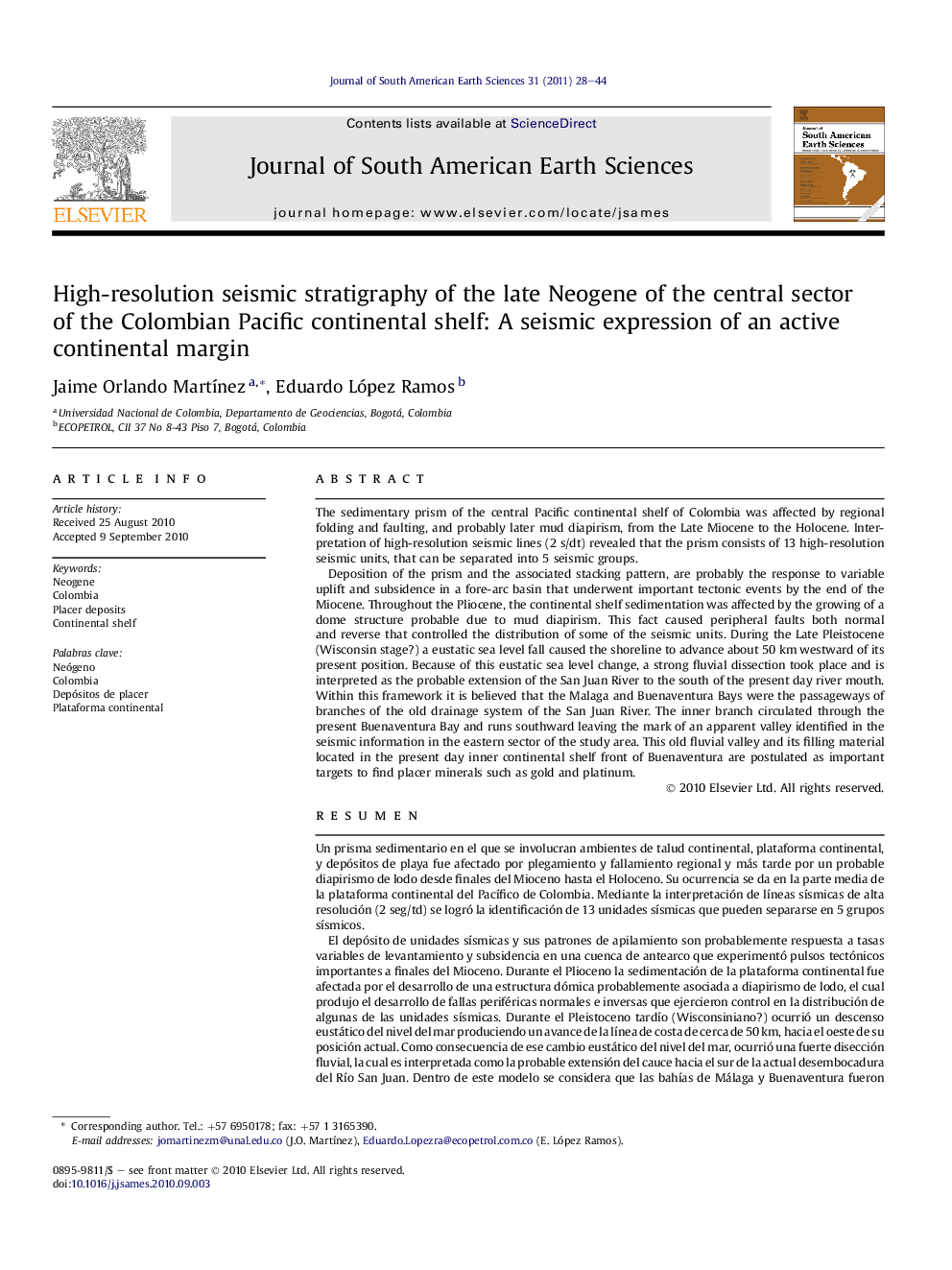| کد مقاله | کد نشریه | سال انتشار | مقاله انگلیسی | نسخه تمام متن |
|---|---|---|---|---|
| 6431493 | 1348926 | 2011 | 17 صفحه PDF | دانلود رایگان |

The sedimentary prism of the central Pacific continental shelf of Colombia was affected by regional folding and faulting, and probably later mud diapirism, from the Late Miocene to the Holocene. Interpretation of high-resolution seismic lines (2 s/dt) revealed that the prism consists of 13 high-resolution seismic units, that can be separated into 5 seismic groups.Deposition of the prism and the associated stacking pattern, are probably the response to variable uplift and subsidence in a fore-arc basin that underwent important tectonic events by the end of the Miocene. Throughout the Pliocene, the continental shelf sedimentation was affected by the growing of a dome structure probable due to mud diapirism. This fact caused peripheral faults both normal and reverse that controlled the distribution of some of the seismic units. During the Late Pleistocene (Wisconsin stage?) a eustatic sea level fall caused the shoreline to advance about 50 km westward of its present position. Because of this eustatic sea level change, a strong fluvial dissection took place and is interpreted as the probable extension of the San Juan River to the south of the present day river mouth. Within this framework it is believed that the Malaga and Buenaventura Bays were the passageways of branches of the old drainage system of the San Juan River. The inner branch circulated through the present Buenaventura Bay and runs southward leaving the mark of an apparent valley identified in the seismic information in the eastern sector of the study area. This old fluvial valley and its filling material located in the present day inner continental shelf front of Buenaventura are postulated as important targets to find placer minerals such as gold and platinum.
ResumenUn prisma sedimentario en el que se involucran ambientes de talud continental, plataforma continental, y depósitos de playa fue afectado por plegamiento y fallamiento regional y más tarde por un probable diapirismo de lodo desde finales del Mioceno hasta el Holoceno. Su ocurrencia se da en la parte media de la plataforma continental del PacÃfico de Colombia. Mediante la interpretación de lÃneas sÃsmicas de alta resolución (2 seg/td) se logró la identificación de 13 unidades sÃsmicas que pueden separarse en 5 grupos sÃsmicos.El depósito de unidades sÃsmicas y sus patrones de apilamiento son probablemente respuesta a tasas variables de levantamiento y subsidencia en una cuenca de antearco que experimentó pulsos tectónicos importantes a finales del Mioceno. Durante el Plioceno la sedimentación de la plataforma continental fue afectada por el desarrollo de una estructura dómica probablemente asociada a diapirismo de lodo, el cual produjo el desarrollo de fallas periféricas normales e inversas que ejercieron control en la distribución de algunas de las unidades sÃsmicas. Durante el Pleistoceno tardÃo (Wisconsiniano?) ocurrió un descenso eustático del nivel del mar produciendo un avance de la lÃnea de costa de cerca de 50Â km, hacia el oeste de su posición actual. Como consecuencia de ese cambio eustático del nivel del mar, ocurrió una fuerte disección fluvial, la cual es interpretada como la probable extensión del cauce hacia el sur de la actual desembocadura del RÃo San Juan. Dentro de este modelo se considera que las bahÃas de Málaga y Buenaventura fueron conductos de tributarios del antiguo drenaje del RÃo San Juan. El tributario más interno se desplazó por la actual bahÃa de Buenaventura y se proyectó hacia el sur, dejando a manera de huella, un antiguo valle el cual es identificado en la información sÃsmica, en el sector oriental de la zona de estudio. Este antiguo valle fluvial y su material de relleno localizado en la actual plataforma continental interna, frente a Buenaventura, se considera un blanco importante en la prospección de minerales de placer, tales como oro y platino.
Journal: Journal of South American Earth Sciences - Volume 31, Issue 1, February 2011, Pages 28-44